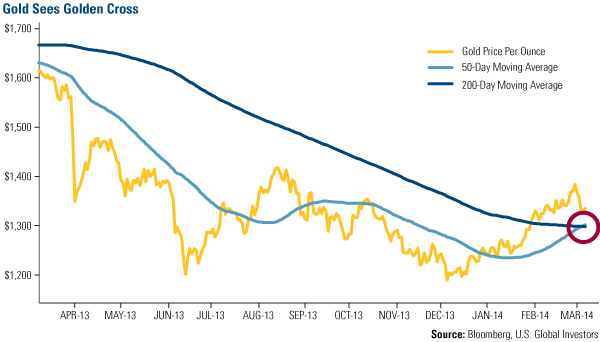Gold Market Radar (March 24, 2014)
For the week, spot gold closed at $1,334.21, down $48.84 per ounce, or 3.53 percent. Gold stocks, as measured by the NYSE Arca Gold Miners Index, declined 8.05 percent. The U.S. Trade-Weighted Dollar Index rose 0.83 percent for the week.
Strengths
- A recent survey commissioned by the Silver Institute’s Silver Promotion Service found that 73 percent of U.S. jewelry retailers reported increased silver sales in 2013. Furthermore, 92 percent of the retailers who responded to the survey said they are optimistic that the current silver demand growth will continue for the next several years. In the platinum group metals space, platinum and palladium have benefitted from platinum strikes in South Africa, as well as the threat of sanctions in Russia, the world’s main palladium producer. Standard Bank is seeking to profit from the instability by launching palladium and platinum ETFs to be listed on the Johannesburg Stock Exchange.
- Mineweb reports the Indian government eased import regulations to allow some of the country’s private sector banks to buy gold from abroad in a move that could boost gold imports in India and bring down physical premiums considerably. The Reserve Bank of India has allowed five private sector banks to participate in the import programs, as the country seeks to prevent the flow of illicit money and smuggled gold ahead of the primary elections this year.
- Paradigm Capital published a report on Dundee Precious Metals, highlighting that after four years of heavy investment, the company’s 100 percent-owned Tsumeb smelter in Namibia is poised to turn around in 2014. The asset should enjoy compound benefits from increased throughput and lower costs, a reality that has been ignored by many market participants who do not understand the value of the asset. Tsumeb is one of only two smelters in the world now capable of handling high arsenic concentrate, allowing Dundee to profit from handling third-party custom smelting. With capacity poised to double and capital investments dropping sharply, the asset could add up to $74 million in EBITDA per year to Dundee.
Weaknesses
- Gold fell after the Federal Reserve indicated that it will raise interest rates next year. The Fed’s tone was deemed as being more hawkish than expected, which contributed to a sharp rise in the dollar. As a result, gold traders turned bearish with a majority of them expecting gold to fall next week.
- U.S. domestic mine gold production in 2013 has dropped 3 percent, or 128,602 ounces, from the prior year, according to estimates released by the U.S. Geological Survey. Production coming from the states of Nevada (the U.S. gold output leader), Arizona, and California decreased in 2013.
- A Wall Street Journal article shows European central banks may end a 15-year-old restriction on sales of their gold holdings. Under the agreement, central banks were limited to selling a maximum of 400 tonnes over a five-year period. According to a Bundesbank board member, the agreement may not be extended because over the past five years central bank gold sales have decreased significantly, making the policy unnecessary.
Opportunities
- On Thursday, gold recorded a golden cross when the 50-day moving average crossed above the 200-day moving average. A golden cross is traditionally associated with the breaking of a bear market trend and the beginning of a bull market, where the 200-day moving average becomes a support level in the rising market. Our analysis shows that, going back to 2000, a golden cross in gold has been followed on average by a 50 percent rally lasting on average 15 months.
- Michael Gray, head of Macquarie Mining Research in Canada, commented on the newfound energy of the gold space in an interview with The Gold Report. According to Gray there are three reasons to believe the sector has turned a corner: (1) few people expected gold prices to rise so quickly into 2014, (2) the environment is fertile for equity deals and M&A transactions, and (3) Goldcorp’s bid for Osisko effectively removed an overhang. In addition, Dennis Gartman, one of the most senior and widely-respected newsletter writers, remains bullish on gold, arguing the curtailing of production by senior miners signals the end of the bear market.
- David Rosenberg, Gluskin Sheff’s Chief Economist, is of the opinion that the Fed appears to be looking at inflation in the rear-view mirror, not through the front window as it should be. Rosenberg agrees that inflation appears benign today; however, the signs of imminent rising inflation cannot be ignored any longer. According to Rosenberg, the National Federation of Independent Business plans to raise selling prices, which has a 70 percent correlation with inflation. In addition, the non-financial commercial paper lending has exploded at a 43 percent annual rate, not a particularly deflationary statistic. As a result, Rosenberg believes we have no “anchor” to hold inflation back.
Threats
- Goldman Sachs’ head of Commodities Research Jeffrey Currie has reiterated his view that gold will fall to $1,050 by the end of the year, leading numerous analysts and investors to question his conclusions. According to Currie, gold’s rally this year has been driven by unsustainable factors, such as the weather-induced slowdown in the U.S., increased geopolitical tensions, and Chinese credit concerns. According to Lawrence Williams, a Mineweb contributor, Currie has avoided any comment related to the continued strength of Asian physical buying and the decided reversal of ETF redemptions, the two most important gold drivers of 2013.
- JPMorgan Chase announced the sale of its physical commodities trading unit to the Mercuria Energy Group. The move was announced as Wall Street Banks are moving out of the commodities trading business to avoid tighter scrutiny by regulators who are currently investigating price fixing allegations. Morgan Stanley and Deutsche Bank have announced similar moves in recent weeks. These transactions, however, are shifting the commodities trading business into the even less regulated market of private companies, at a time when the sector has seen consolidation. The end result likely will be a market with fewer players and less transparency – hardly desirable for commodities producers.
- As a result of the speculation on Chinese commodity trade financing in copper and iron ore unwinding due to capital tightening, UBS published a report on gold-trade financing. In conversations with market participants, UBS has found evidence that gold is also being used for trade finance, albeit to a small degree. This is because gold has proven harder to use for financing as it is more closely monitored by regulators, and its value makes storage arrangements more complicated and costly.















